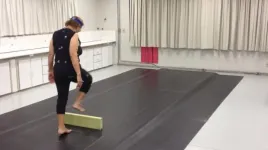(Press-News.org) By Karina Ninni | Agência FAPESP – A multidisciplinary research group affiliated with the Department of Physical Education’s Human Movement Laboratory (Movi-Lab) at São Paulo State University (UNESP) in Bauru, Brazil, measured step length synergy while crossing obstacles in patients with Parkinson’s disease and concluded that it was 53% lower than in healthy subjects of the same age and weight. Step length is one of the main variables affected by the disease.
Synergy, defined as combined operation, refers in this case to the capacity of the locomotor (or musculoskeletal) system to adapt movement while crossing an obstacle, combining factors such as speed and foot position, for example. Improving synergy in Parkinson’s patients while they are walking can make a significant difference to their quality of life, as they tend to fall three times more often on average than healthy people of the same age.
“There are patients in our exercise group who fall three or four times a week. It’s important to understand how these patients’ gait and locomotion adapt while crossing obstacles so that we can improve step-length synergy. This approach enables us to refine the exercise protocol, improve locomotion, and try to reduce fall frequency,” said Fabio Augusto Barbieri, a professor in UNESP’s Department of Physical Education and its Movement Science Graduate Program.
An article on the study is published in the journal Gait & Posture. Barbieri is the last author. The first author is mechanical engineer Satyajit Ambike, a professor in the Department of Health and Kinesiology at Purdue University in the United States. The study is the first to report on impaired locomotor synergies in Parkinson’s patients.
“The innovation in our study is its focus on gait timing, or rhythmicity, the constancy with which patients position their feet to maintain locomotion,” Barbieri said. “This can be evaluated by measuring step-length synergy. Synergy presupposes a goal and has to do with the way the locomotor system adjusts to achieve it. In our case, we investigated how the system adapts to achieve the objective of crossing an obstacle during locomotion.”
The researchers found that Parkinson’s patients are less able to adapt the position of their feet than healthy people as they approach and cross an obstacle. “The locomotor system always tries to adapt in order to maintain constancy during locomotion. Absent this constancy, we may make mistakes that can lead to a fall,” Barbieri said. “Parkinson’s patients are less constant in positioning their feet while walking, and gait timing tends to be unstable as a result. Their speed rises and falls as they walk, and step length varies along with foot placement.”
Obstacles
Thirteen Parkinson’s patients and 11 neurologically healthy controls participated in the study. All participants were over 50. To be eligible they had to be able to walk without assistance, to have normal sight and hearing (with or without lenses and hearing aids), to have no orthopedic or neurological diseases apart from Parkinson’s, and to be able to understand and follow instructions. The patients took medication for Parkinson’s (Levodopa) for at least three months before data collection.
The participants had to walk along a gangway (length 8.5 m, width 3.5 m), and cross a foam rubber obstacle (height 15 cm, width 60 cm, depth 5 cm) placed 4 m from the starting point. Gait speed was not imposed but chosen by each participant. No instructions were given regarding which leg should cross the obstacle first, but its position was adjusted for each participant so that the right leg had to lead.
“We tried to standardize the task so that all the subjects crossed the obstacle with their right leg leading,” Barbieri said. “The idea was to ensure there was no interference from other factors in the locomotion pattern. The height of the obstacle was 15 cm because that’s the standard curb height in Brazil. We thought it would be best to stick to the standard.”
A number of systems need to work together for synergy to happen in terms of achieving an objective, he explained. “When the distance between the toes and the obstacle [before it is crossed] and between the heel and the obstacle [after it is crossed] varies a lot, the risk of contacting the obstacle increases. Being too close to the obstacle before crossing entails having to raise the leading leg so high that it may prove impossible. If the trailing foot comes down too close to the obstacle after crossing, the heel is likely to touch it,” he said, adding that gait timing should ideally be constant and the foot should not come too close to the obstacle on either side.
Biomechanics
Step-length synergy was measured using a methodology derived from mechanical engineering and adapted to the study of human movement. The methodology is not specific to gait analysis or Parkinson’s, but adapted from a set of techniques used to measure upper-limb strength by Ambike and Mark Latash of Pennsylvania State University.
Eight motion capture cameras used in the study were purchased with funding from FAPESP (grant no. 2017/19516-8). The study was also supported by a visiting researcher grant.
Twenty reflective markers were placed according to a specific gait analysis model on the body of each participant in the experiment. “While the subject is walking along the gangway toward the obstacle and crossing it, the cameras emit infrared light, which is reflected by the markers. The cameras capture the position of the markers, enabling us to determine step length and duration. Gait analysis software does the other calculations,” Barbieri explained.
The study was the first time this methodology was applied to gait analysis, according to Barbieri. “Another innovation was that we used a single variable to detect possible gait timing-related incapacities relatively simply, facilitating more consistent future intervention to improve gait timing via training,” he said. “This is the point of gait analysis in general. You want to determine possible variables of changes in gait and modify intervention on that basis.”
The same researchers have since begun a study to find out whether the height of the obstacle affects step-length synergy. “We want to know if this synergy changes because the obstacle is higher or lower. This concerns the environment in which the patient moves. If there are obstacles of a certain height in the area, they may cause problems and lead to falls, so we can modify the environment to facilitate locomotion,” Barbieri said.
The article “Step length synergy while crossing obstacles is weaker in patients with Parkinson’s disease” by Satyajit Ambike, Tiago Penedo, Ashwini Kulkarni, Felipe Balistieri Santinelli and Fabio A. Barbieri can be retrieved from: www.sciencedirect.com/science/article/abs/pii/S0966636221000011.
Study shows why crossing obstacles is difficult for patients with Parkinson's disease
The scientists detected incapacities related to gait timing and foot placement. Their discoveries serve as a basis for the development of an exercise protocol that mitigates the difficulty.
2021-04-07
ELSE PRESS RELEASES FROM THIS DATE:
Crunching on coral
2021-04-07
You might not think an animal made out of stone would have much to worry about in the way of predators, and that's largely what scientists had thought about coral. Although corallivores like parrotfish and pufferfish are well known to biologists, their impact on coral growth and survival was believed to be small compared to factors like heatwaves, ocean acidification and competition from algae.
But researchers at UC Santa Barbara have found that young corals are quite vulnerable to these predators, regardless of whether a colony finds itself alone on the reef or surrounded by others of its kind. The research, led by doctoral student Kai Kopecky, appears in the journal Coral Reefs.
Kopecky and his co-authors ...
Unraveling the mysteries of sleep disorders in multiple system atrophy
2021-04-07
Unusual diseases are medical mysteries that fascinate us, and one such disease is multiple system atrophy, or MSA. This rare neurological disorder causes failures in the proper functioning of the body's autonomic system (processes that are not under our conscious control, such as blood pressure, breathing, and involuntary movement). The resulting symptoms can look like two other types of neurodegenerative disease: Parkinson's disease and cerebellar ataxia. In fact, MSA can be separated into a parkinsonism subtype or a cerebellar subtype based on whether the resultant movement-related ...
Junctions between three cells serve as gateways for the transport of substances
2021-04-07
Within multicellular organisms, cells build connections with each other forming cell layers that cover the surfaces of tissues and organs and separate structures in the body. For example, the skin forms a mantle around the entire organism, and the layer of cells lining the blood vessels creates a boundary between the bloodstream and tissues. Special connections between neighbouring cells ensure that these cellular barriers are, on the one hand, stable and tight - thus protecting the body and organs against pathogens - while, on the other hand, they remain permeable to specific substances or migrating cells. This is how the cells allow dissolved ...
Framework could support more reliable electric power distribution systems
2021-04-07
Imagine the process of distributing electricity to homes from the power grid is like travelers boarding a train.
There are multiple steps to take before they can reach their final destination. First, they have to buy a ticket at the ticketing booth - this is where the power is generated. Then, they board a train that departs from the station - the power is transmitted over distances using transmission lines. Finally, the train takes the travelers (electricity) to their final destination. This final step of sending power to homes and businesses is called the distribution system - and it is critical that ...
Mounting hope for new physics
2021-04-07
Today, the Muon g-2 Collaboration finally published the highly anticipated first result from its measurement of the anomalous magnetic moment of the muon, a precision quantity that offers physicists one of the most promising means to test predictions of the actual Standard Model of particle physics. The measured value, which is more precise than all values before, strengthens evidence for the emergence of new physics beyond the Standard Model, and thus for the existence of previously unknown particles or forces. The result was presented at an online ...
For girls, learning science outside linked to better grades, knowledge
2021-04-07
In a new study, North Carolina State University researchers found that an outdoor science program was linked to higher average science grades and an increase in a measure of science knowledge for a group of fifth grade girls in North Carolina.
The findings, published in the International Journal of Science Education, indicates outdoor education could be a promising tool to help close gender gaps in science.
"The outdoors is a space where teachers can find tangible ways to make science come alive," said the study's lead author Kathryn Stevenson, assistant professor of parks, recreation and tourism management at NC State. "The natural environment is also a place that everybody has in common. In a way, it's also a great context for employing reform-based teaching practices ...
Conspiracy theories and cognitive biases in the COVID-19 pandemic
2021-04-07
Conspiracy theories appear to be increasing in popularity as the Covid-19 pandemic continues. But to what extent do people really agree with them, and what is the association with cognitive biases? A research team from the University of Basel studied these questions in German-speaking Switzerland and Germany.
Periods of crisis are often conducive to the emergence and spread of conspiracy theories, and the Covid-19 pandemic is a case in point. A research team led by Sarah Kuhn and Dr. Thea Zander-Schellenberg of the University of Basel has investigated the endorsement rates of coronavirus-related conspiracy theories in German-speaking Switzerland and Germany, ...
Particle physics: Will muons lead us towards a new physics?
2021-04-07
Muons, particles akin to electrons, have kepts physicists' heads spinning for more than a decade, because an experimental measurement of their magnetic properties (1) disagrees with theory. Could this be caused by unknown particles or forces?
A new theoretical calculation of this parameter, involving CNRS physicists and published in the journal Nature, has reduced the discrepancy with the experimental measurement. The debate nevertheless continues.
--
For over 10 years, measurement of the magnetic properties of the muon (an ephemeral cousin of the electron) has exhibited disagreement with theoretical predictions. This ...
800-year-old medieval pottery fragments reveal Jewish dietary practices
2021-04-07
A team of scientists, led by the University of Bristol, with archaeologists from Oxford Archaeology, have found the first evidence of a religious diet locked inside pottery fragments excavated from the early medieval Jewish community of Oxford.
Keeping kosher is one of the oldest known diets across the world and, for an observant Jew, maintaining these dietary laws (known as Kashruth) is a fundamental part of everyday life. It is a key part of what identifies them as Jews, both amongst their own communities and to the outside world.
Oxford's Jewish quarter was established around St. Aldates in the twelfth and thirteenth centuries, following William the Conqueror's invitation ...
Gender inequality study shows women under-represented on marketing academic journal boards
2021-04-07
Women are significantly underrepresented in the editorial boards of marketing academic journals, and awards and recognition favour men, new research from the University of Bath School of Management has found.
In their study 'It's hard to be what you can't see - gender representation in marketing's academic journals', Professor Andrea Prothero of Business and Society at University College Dublin and co-researcher Professor Pierre McDonagh examined gender representation in 20 marketing academic journals through three areas - the gender composition of editorial boards, special issue celebrations ...
LAST 30 PRESS RELEASES:
Orthopedics can play critical role in identifying intimate partner violence
Worms as particle sweepers
Second spider-parasitic mite described in Brazil
January 2026 issues of APA journals feature new research on autism, pediatric anxiety, psychedelic therapy, suicide prevention and more
Private equity acquired more than 500 autism centers over the past decade, new study shows
New cervical cancer screening guidelines from the US Department of Health and Human Services
Estimated burden of COVID-19 illnesses, medical visits, hospitalizations, and deaths in the US from October 2022 to September 2024
Smartphone use during school hours by US youth
Food insecurity and adverse social conditions tied to increased risk of long COVID in children
Earliest, hottest galaxy cluster gas on record could change our cosmological models
Greenland’s Prudhoe Dome ice cap was completely gone only 7,000 years ago, first GreenDrill study finds
Scientific validity of blue zones longevity research confirmed
Injectable breast ‘implant’ offers alternative to traditional surgeries
Neuroscientists devise formulas to measure multilingualism
New prostate cancer trial seeks to reduce toxicity without sacrificing efficacy
Geometry shapes life
A CRISPR screen reveals many previously unrecognized genes required for brain development and a new neurodevelopmental disorder
Hot flush treatment has anti-breast cancer activity, study finds
Securing AI systems against growing cybersecurity threats
Longest observation of an active solar region
Why nail-biting, procrastination and other self-sabotaging behaviors are rooted in survival instincts
Regional variations in mechanical properties of porcine leptomeninges
Artificial empathy in therapy and healthcare: advancements in interpersonal interaction technologies
Why some brains switch gears more efficiently than others
UVA’s Jundong Li wins ICDM’S 2025 Tao Li Award for data mining, machine learning
UVA’s low-power, high-performance computer power player Mircea Stan earns National Academy of Inventors fellowship
Not playing by the rules: USU researcher explores filamentous algae dynamics in rivers
Do our body clocks influence our risk of dementia?
Anthropologists offer new evidence of bipedalism in long-debated fossil discovery
Safer receipt paper from wood
[Press-News.org] Study shows why crossing obstacles is difficult for patients with Parkinson's diseaseThe scientists detected incapacities related to gait timing and foot placement. Their discoveries serve as a basis for the development of an exercise protocol that mitigates the difficulty.




